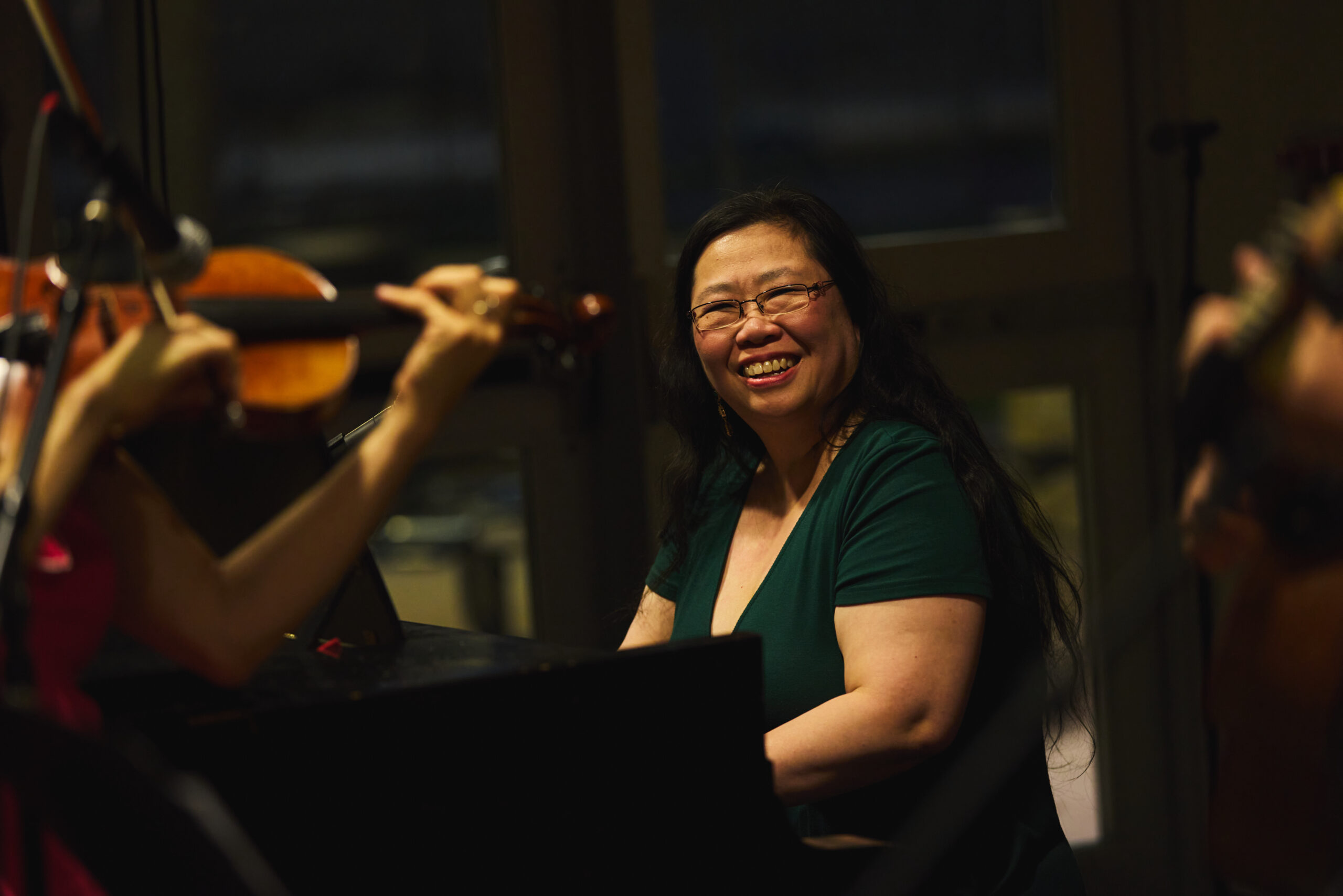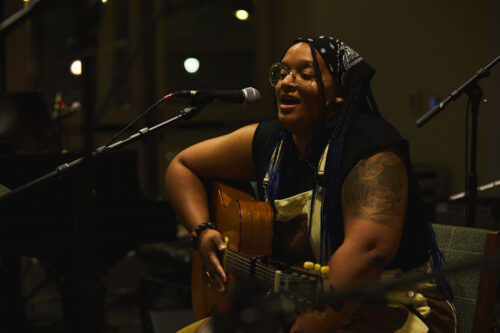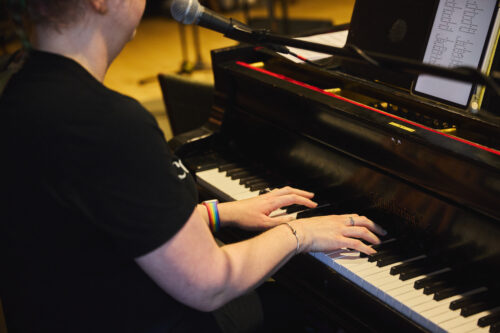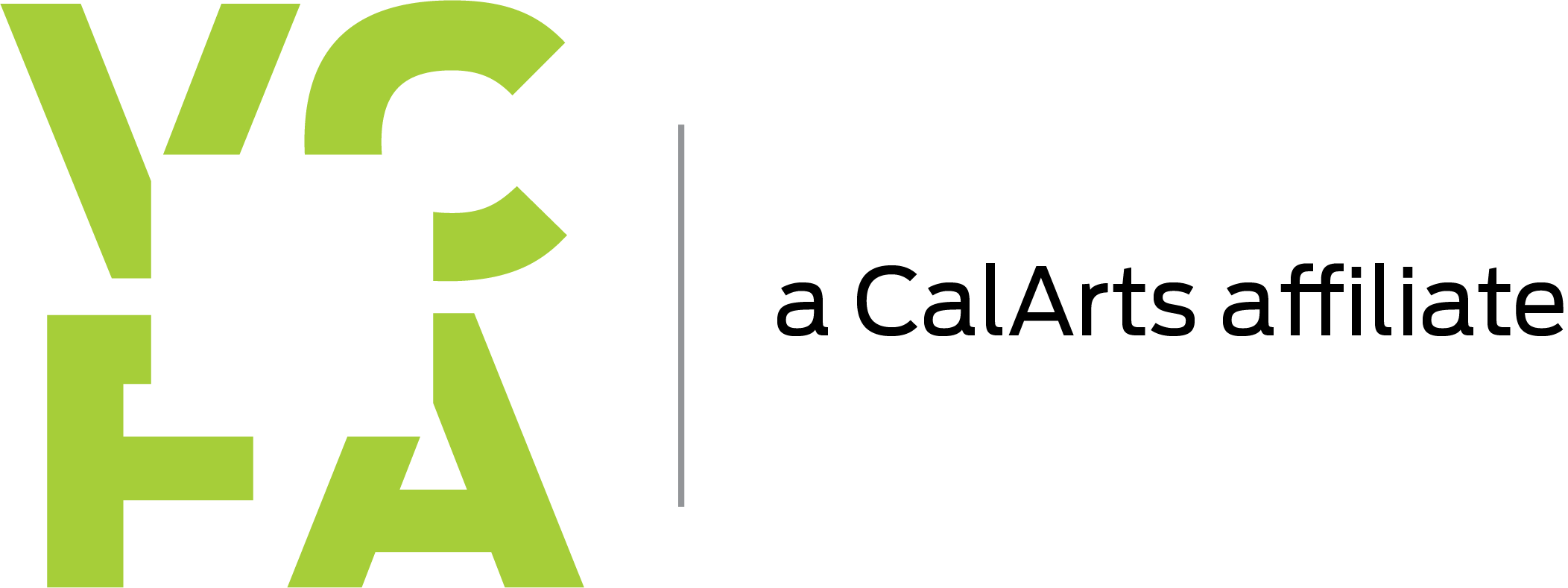A Music Theory Definition To Encourage Your Creativity

Music theory can be defined as a shared language that allows us to talk about music and how it affects us. Pictured here: MFA in Music Composition faculty member Trudy Chan.
By Michael Early
May 19th, 2025
The experience of music is intensely personal. Music theory gives us a shared language for discussing that experience. However, music theory is more than just the frameworks we use to understand and talk about music—it’s also a path to deeper creativity.
Music theory has the power to focus your creative practice.
By understanding the “rules” of music, you’ll know how and when to break them to create something uniquely yours. In this article, I’ll cover three essential points that connect music theory to the living practice of music:
- Music theory can have many different goals, including empowering the artist
- Musical theory follows musical practice in defining its parts, and their relationships
- Composers often lead the development of new music theory tools
Music theory can have many different goals—including empowering art
I started learning piano at the age of five from my mom, and I always skipped over the theory sections in the piano books. I didn’t see why I should care. My mother told me it would come in useful someday—and she was right! But it wasn’t until my undergraduate work when I was studying piano and musicianship and theory and composition all together that I began to see the relationships beneath the surface.
There is a strongly innate human desire to categorize things. Whether or not we verbally articulate it as creators of music, we do use frameworks of ideas to order our musical process. Music theory expresses these frameworks of musical practice by using verbal language and/or musical notation.
Music theory can be put to different uses:
- to parse how a listener experiences music (music cognition and perception)
- to place music in its cultural/historical context (historical musicology)
- to analyze the “language” and meaning of a composition by borrowing techniques from linguistics (musical semiotics)
- to explore organizational principles from the creator’s side‚the composer’s perspective
As a practicing composer, it’s this last perspective I want to focus on.
In the American Heritage Dictionary on my shelf, the third definition of the word “theory” is a “belief that guides action or assists comprehension or judgement.” If we apply that to music we might say that: we as artists are guided by a system of beliefs reflected in the techniques we use to create music.
This could be something we are given, or it could be something we choose. Are we maintaining a cultural tradition that would die without us? Or are we merging previously unrelated ideas into something new? In practice, often both are true.
Articulating a theory of that practice can help us accelerate our creativity down the paths we want to follow in our imagination. It can also express what we as creators are trying to do—both to the performers we work with and the audience we are sharing it with.
Composer Steve Reich, in an interview with NPR, said:
“When Bartók wrote his string quartets, people would look at him and say, ‘Are you kidding? You expect us to do that?’ But a couple of quartets dug in and spent time and really rehearsed them and came up with beautiful versions of them. Anything that really introduces new techniques and new difficulties is going to first appear in the hands of specialists.”

Once you understand the “rules” of music theory, you can start to break them and unleash your creativity.
Musical theory follows musical practice
Before I learned a lick of music theory in any formal institution, I inherited the language of it through singing and playing in church choirs, rock bands, and jazz combos.
Chords were tones that sounded good together. Scales were a place to start when playing a solo or singing a melody. We didn’t call it counterpoint at the time, but when our band’s bass player figured out the “right” notes and rhythms to play against the singer’s melody or the guitarist’s chords, it was counterpoint anyway.
As creative musicians, we construct our own musical principles. If we want to create music in a specific style or tradition we can dig deep into live performance, scores, recordings, or writings, and then we start by making connections and establishing relationships. If we feel like being contrarian (and what artist doesn’t sometimes?), we can look for the spaces between the theories we’ve heard or read or made ourselves and build something new out of that.
OK, so, what? Anything goes?
Well, to take a line from Bob Dylan’s “Absolutely Sweet Marie,” “… to live outside the law you must be honest.”
Music theory is not a set of laws, but it is a set of tools—they enable musical practice and authenticity.
They can guide our musical ship in a straight line, or we can use them to tack left and right and see where we end up. Either way, choosing some musical principles as a personalized definition of music theory allows us to frame our creativity and our relationship to a musical community.
To do that, we need to be reflective. What are the techniques that we keep in our back pocket to get the work of creation accomplished? These are our theory tools. Scales, chords, tunings, formal structures, principles of arrangement, qualities of tone or timbre, even the cadence of spoken language; these are all elements that can be approached with a critical eye and ear in the creative process.

Composers are often at the forefront of music theory, redefining what we can and can’t do with music.
Composers often lead the development of new music theory tools
It is often composers and other practicing musicians that are at the forefront of creating new definitions of what music theory is and what it can be, allowing our creative practice to evolve and emerge from our own lived experience.
Here are a few examples of what this has meant for composers in the past:
Johann Joseph Fux
Johann Joseph Fux, born a peasant in the late 17th century, eventually became the court composer to Austrian Emperor Leopold the First. At the end of his life, he wrote “Gradus ad Parnassum,” where he outlined a mathematical basis for musical intervals, as well as a practical method called species counterpoint. Grounded in the music of the Catholic Church at the time, and especially the music of Palestrina, species counterpoint is still used in many music curricula as practical exercises and a case study in how musical voices fit together.
Ruth Crawford
Ruth Crawford, an American composer and a chronicler of American folk song, turned traditional interval relationships on their head in compositions like “White Moon” from her Five Songs. Crawford made dissonant intervals the pillars of her music instead of the consonant ones. Her partner Charles Seeger (also a composer and musicologist) articulated this in a loose theory of “dissonant counterpoint.” Similar ideas were used by other twentieth century composers, including Henry Cowell as outlined in his book New Musical Resources.
Ben Johnston
American composer Ben Johnston developed a lifelong interest in the mathematics and sonic possibilities of tunings in music using ideas going back to the ancient Greeks (these are related to those outlined in Fux, mentioned above). These ideas also relate to tunings found in Indian classical music and American jazz. He explored a very nuanced relationship between harmony, counterpoint, and tuning in a series of uniquely beautiful string quartets.
And what does theory mean for me, personally?
I consider myself a very intuitive composer, responding to my current musical environment. This can be a great strength, but to paraphrase one of my undergraduate professors, sometimes it’s hard to “put on blinders” and get the work of creation done, choosing among all the many possibilities that a creative idea can follow.
Having experience with theory has enabled me to zoom in on the qualities and potentials of a musical idea and to self-critique passages that don’t feel quite right yet. It also helps me get inside the music of artists I love and take new techniques into my own vocabulary.
In my dissertation work, I transcribed and analyzed rock music from the 1970’s—specifically the album Relayer by the band Yes, in the context of the rhetoric of science fiction and fantasy literature. That theoretical work has given me fresh insight into making new music of my own, like this album for violin & electric guitar.
Music theory is a catalyst for creativity
Nadia Boulanger, a French composer, teacher, and conductor in the twentieth century, taught generations of composers and other musicians including Aaron Copland, Philip Glass, and Quincy Jones. She continued to teach a version of the species counterpoint mentioned above. In an article from the music journal Tempo in June 1986, she is quoted as saying:
“You need an established language and then, within that established language, the liberty to be yourself.”
Practicing artists define musical elements and techniques not to exclude, but to catalyze musical possibilities. When we choose to step outside the “rules,”, we engage with our intuition.
Music theory can help focus this intuition and its intention, so that we don’t feel lost, out on the open sea of creativity.

Michael Early
Composer and Music Educator, Founding core faculty at VCFA's MFA in Music Composition michaelearly.orgMichael Early is most at home making music at the fuzzy borders between established traditions. He has created music for traditional Western orchestras, electronic laptop orchestras, acoustic chamber groups, voice, piano & electronics, solo percussion, and electric guitars. Trained as a pianist, he also plays electric guitar with the duo X10. Under the name ThreeAcrePlot he creates and performs songs for his voice and a variety of instruments. He holds degrees in music from Yale University (B.A.), USC Thornton School of Music (M.M.), and Princeton University (Ph.D.).
Related Posts
- A Deep Dive Into Film Scoring Opportunities May 28, 2025
- 7 Tips for How to Write a Picture Book May 26, 2025
- What is Prose? Jun 20, 2025

